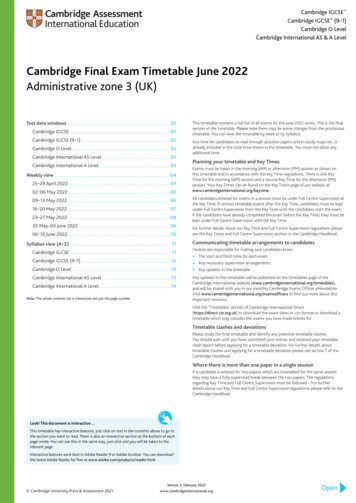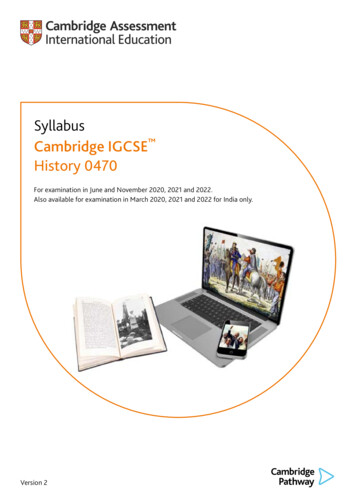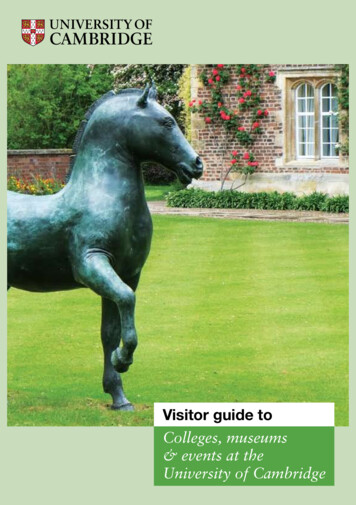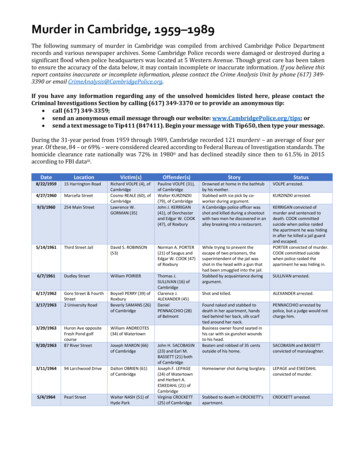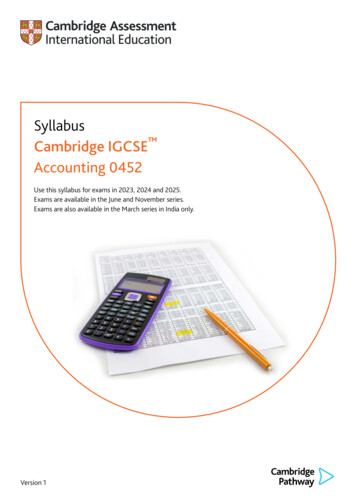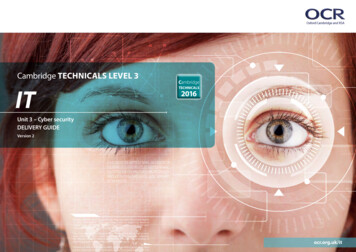
Transcription
Cambridge TECHNICALS LEVEL 3ITUnit 3 – Cyber securityDELIVERY GUIDEVersion 2ocr.org.uk/it
CAMBRIDGE TECHNICALS IN ITCONTENTSIntroduction3Key Terms4Misconceptions8Suggested Activities:Learning Outcome (LO1)Understand what is meant by cyber security9Learning Outcome (LO2)Understand the issues surrounding cyber security12Learning Outcome (LO3)Understand measures used to protect against cybersecurity incidents19Learning Outcome (LO4)Understand how to manage cyber security incidents27Related Activities31LEVEL 3 UNIT 3The activities within this teaching and learning resource must not be used forsummative assessment purposes. As part of our teaching we expect supportto be given to your learners; such support is not permissible for summativeassessment and is likely to be considered malpractice.2
CAMBRIDGE TECHNICALS IN ITINTRODUCTIONThis Delivery Guide has been developed to provide practitioners with a variety ofcreative and practical ideas to support the delivery of this qualification. The Guideis a collection of lesson ideas with associated activities, which you may find helpfulas you plan your lessons.OCR has collaborated with current practitioners to ensure that the ideas put forward inthis Delivery Guide are practical, realistic and dynamic. The Guide is structured by learningoutcome so you can see how each activity helps you cover the requirements of this unit.We appreciate that practitioners are knowledgeable in relation to what works for themand their learners. Therefore, the resources we have produced should not restrict orimpact on practitioners’ creativity to deliver excellent learning opportunities.Whether you are an experienced practitioner or new to the sector, we hope you findsomething in this guide which will help you to deliver excellent learning opportunities.If you have any feedback on this Delivery Guide or suggestions for other resources youwould like OCR to develop, please email resources.feedback@ocr.org.uk.OPPORTUNITIES FOR ENGLISH AND MATHSSKILLS DEVELOPMENTWe believe that being able to make good progress in English and maths is essential tolearners in both of these contexts and on a range of learning programmes. To help youenable your learners to progress in these subjects, we have signposted opportunities forEnglish and maths skills practice within this resource. These suggestions are for guidanceonly. They are not designed to replace your own subject knowledge and expertise indeciding what is most appropriate for your learners.English Maths WorkUNIT AIMThe need for secure digital systems is more crucial than ever before. We rely on computerisedsystems and networks to collect, process, store and transfer vast amounts of data and to controlcritical systems such as water and power supplies. Business and e-commerce can be undertakentwenty four hours a day, seven days a week and telecommunications enable us to keep in touchwith family and friends and collaborate with colleagues at any time. Mobile devices offer us freedomand flexibility of where and how we learn and work. However, for all the advantages that thesesystems offer us, some people have found ways to exploit them and this poses a threat to our safetyand security in the real world, as much as in the cyber world. To deal with this problem the cybersecurity industry is expanding at a rapid rate.This unit has been designed to enable you to gain knowledge and understanding of the range ofthreats, vulnerabilities and risks that impact on both individuals and organisations. You will learnabout the solutions that can be used to prevent or deal with cyber security incidents resulting fromthese challenges. You will be able to apply your knowledge and understanding of cyber securityissues and solutions by reviewing and making recommendations for ways to best protect digitalsystems and information. Learning within this unit will also support the delivery of the Cisco CyberSecurity and CompTIA A , CompTIA Security , CompTIA Mobility qualifications. The unit alsomakes reference to UK government cyber security initiatives, for example, the UK government’sThe UK Cyber Security Strategy, Cyber Essentials Scheme, 10 Steps Strategy and Cyber Streetwise.Unit 1 TITLELO1Understand what is meant by cyber securityLO2Understand the issues surrounding cyber securityLO3Understand the measures used to protect against cyber security incidentsLO4Understand how to manage cyber security incidentsTo find out more about this qualification please go to: 5838-05842-2016-suite/Please noteThe timings for the suggested activities in this Delivery Guide DO NOT relate tothe Guided Learning Hours (GLHs) for each unit.LEVEL 3 UNIT 3Assessment guidance can be found within the Unit document available fromwww.ocr.org.uk.The latest version of this Delivery Guide can be downloaded from the OCR website.2016 Suite New suite for first teaching September 2016Externally assessed contentEligible for Key Stage 5 performance points from 2018Designed to meet the DfE technical guidance3
CAMBRIDGE TECHNICALS IN ITKEY TERMSExplanations of the key terms used within this unit, in the context of this unitKey termExplanationAccess management Managing the access to a computer system/network. It includes procedures such as account administration, account maintenance, account monitoring and therevocation of an account.LEVEL 3 UNIT 3Account lockoutA software security method performed by operating system software that locks any account when a user fails a login attempt more than a set number of times. Forexample, system software can be set up to lock an account for several hours if the user fails the login three consecutive times in a set time frame.Anti-malwareSoftware designed to prevent, detect and eradicate malicious software, such as a virus or a worm.Anomaly basedSoftware that is designed to detect computer intrusions and misuse by monitoring system activity and classifying it as either normal or anomalous.AssetSomething that is of value to a person, an organisation or a state, e.g. data, finance and secrets that should be secured against cyber security incidents.AttackerIndividuals or organisations that target computer systems/networks illegally.Audit trailA record of activities on a computer system/network, for example, a record of modifications to data or access to parts of a system/network.AvailabilityData/information stored on a computer system/network must be available to authorised users and organisations and be protected from unauthorised deletion.Biometric accessAccess to a computer system/network using technologies that measure and analyse human body characteristics for authentication purposes, such as DNA,fingerprints, retinas, voice patterns, facial patterns and hand measurements.BotnetA network of computers infected with malicious software and controlled without the owners’ knowledge, for example, to send spam or hoax emails.Business continuityplanA plan to continue operations that an organisation will follow if it is affected by a cyber security incidentConfidentialityInformation stored on a computer system/network must be protected against unintended or unauthorised access. Data confidentiality is a measure of the ability ofa system to protect its data.Cyber criminalAn individual who commits illegal activities using computers and the Internet.Cyber dependantIllegal activities dependent on the use of computers and the Internet, such as hacking or the distribution of malware on a network.Cyber enabledIllegal activities that could be undertaken without the use of computers, such as fraud but that are enabled by the use of computers, such as fraudulently obtainingmoney for goods online.4
CAMBRIDGE TECHNICALS IN ITExplanations of the key terms used within this unit, in the context of this unitKey termExplanationCyber securityRefers to technologies, processes and practices designed to protect computers, networks, software and data from attack, damage or unauthorised access and aimsto protect data confidentiality, integrity and availability.Cyber securityincidentAn unwanted/unexpected event, such as an intrusion into a computer system/network, such as the spread of malware.Cyber securityincident reportA report that documents the details of a cyber security incident, such as the type of incident, when it occurred, how it was performed, etc.Denial of serviceAn attempt to disrupt a network/business/organisation by issuing more requests than a system is able to cope with, it can be performed with malicious intent or asa protest.Disaster recoveryplanA plan that documents a set of procedures for an organisation to follow in order to recover and protect a computer system and its data in the event of a cybersecurity incident.EncryptionA method that is used to attempt to ensure data security by use of encrypted (secret) code. In order to read the contents of an encrypted message or file, someonemust have access to a secret key or password that will enable them to decrypt the message or file.Escalation ofprivilegesExploiting a weakness or weaknesses in an operating system or software application, such as a bug, design flaw or configuration oversight and gaining elevatedaccess to resources that are normally protected.Ethical hackingAn individual who attempts to penetrate a computer system/network on behalf of its owners for the purpose of finding security vulnerabilities that a malicioushacker could potentially exploit. He or she is also known as a white hat hacker. He or she can also work alone.FirewallSoftware that is designed to protect a computer system/network from unauthorised access and intrusion.FuzzingA method that is used to test the security of software.HackingA method of gaining unauthorised access to a computer system/network.HackerAn individual who gains unauthorised access to a computer system/network.HacktivistAn individual who gains unauthorised access to computer system/network for social or political purposes.Hoax emailUsually an email message warning recipients of a non-existent threat, usually forging quotes supposedly from authorities such as Microsoft and IBM.LEVEL 3 UNIT 35
CAMBRIDGE TECHNICALS IN ITKEY TERMSExplanations of the key terms used within this unit, in the context of this unitKey termExplanationHoneypotDecoy servers or computer systems that are set up to gather information on intruders or attackers of computer systems/networks.Host firewallSoftware that runs on a single host computer that restricts incoming and outgoing network activity for that host computer only. It can be used to prevent a hostcomputer from becoming infected and stop infected host computers from spreading malware to other hosts computers.InsiderAn individual working inside an organisation, a trusted employee, who performs an illegal action, such as hacking.IntegrityIntegrity of data aims to protect data from unauthorised modification.Intrusion detectionsystemSoftware that monitors network or system activities for unexpected or malicious activities.Intrusionprevention systemSoftware that examines network traffic flows to detect and prevent vulnerability exploits.MalwareSoftware that is designed to cause disruption or damage to data and/a computer system/network.MitigateTo lessen an impact, for example, the impact of a cyber security incident or a risk.Patch managementAcquiring, testing and installing code changes or patches to software on a computer system/network.Penetration testingA software tool that tests a computer system/network to find vulnerabilities that could be exploited by an attacker.PhisherAn individual that attempts to acquire personal information, often for malicious reasons, such as fraud, by pretending to be a known and trusted individual ororganisation.PhishingThe act of attempting to acquire personal information, often for malicious reasons, such as fraud, by pretending to be a known and trusted individual ororganisation.Non repudiationEnsures that an individual cannot deny the authenticity of their signature on a document or the sending of a message that they sent.LEVEL 3 UNIT 36
CAMBRIDGE TECHNICALS IN ITKEY TERMSExplanations of the key terms used within this unit, in the context of this unitKey termExplanationRiskA threat to a computer system/network can result in a risk, for example, if a hacker gains access to a person’s computer, there is a risk that data will be stolen.Risk analysisThis involves analysing a computer system or a set of procedures and assessing whether a system is at risk from a cyber incident due to weaknesses orvulnerabilities in software, hardware or procedures.Risk managementThis refers to ensuring that risks are monitored carefully and mitigated against or eliminated from a computer system/network.SandboxingThis is a security method for separating running programs on a computer system/network. It is often used to run untested code, or untrusted programs fromunknown sources such as suppliers, untrusted users and untrusted websites.ScammerAn individual who attempts to gain, for example, money from another person by fraudulent means enabled by the use of computers and the Internet.Script kiddieAn individual who uses existing computer scripts or codes to hack into computer systems. They do not have the expertise to write their own code.Signature basedA digital signature is code that is attached to an electronically transmitted document to verify its contents and the sender’s identity.Social engineeringHackers use this non-technical method to access computer systems/networks without authorisation. It involves fooling people into breaking normal securityprocedures, such as guarding their passwords and relies on manipulating the good nature of individuals.SpywareMalware software that is designed to obtain covert information about someone else’s computer activities by transmitting data covertly, from their hard drive, forexample key logging software.ThreatAn action that when performed on a computer system/network can cause destruction or disruption, for example, a hack or malware.UnauthorisedaccessGaining access into a computer system/network illegally.VirusMalicious software which is capable of copying itself and corrupting computer systems/networks or destroying data.VulnerabilityIs a weakness in a computer system/network that can be exploited by a threat, for example, out of date anti-malware software can result in the threat of a malwareattack. If a computer system/network’s vulnerabilities can be found and dealt with, this will help to minimize threats and risks.Vulnerability broker An individual who exploits a vulnerability or weakness in a computer system/network for gain, for example, a hacker.LEVEL 3 UNIT 37
CAMBRIDGE TECHNICALS IN ITMISCONCEPTIONSSome common misconceptions and guidance on how they could be overcomeWhat is the misconception?How can this be overcome?Resources which could helpThe difference betweenvulnerability, threat and riskLearners often confuse the terms vulnerability, threat and risk. Explanations and examples, such asthose referred to in the resources link, may be a way for learners to understand and remember thedifference.Assessment Types - CompTIA Security SY0401: 3.7CompTIAhttps://www.youtube.com/watch?v KXuKFckeHzsA video that discusses the differencesbetween risks, vulnerabilities and threats.The difference between a virus, aworm, a Trojan and a botLearners sometimes do not understand the differences between a virus, a worm, a Trojan and a bot.Explanations and examples, such as those referred to in the three resources links, may be a way forlearners to understand and remember the differences between the terms.What Is the Difference: Viruses, Worms,Trojans, and intelligence/virus-worm-diffs.htmlA webpage that discusses the differencesbetween viruses, worms, Trojans, and Bots?Malware Overview - CompTIA Security SY0-401: 3.1CompTIAhttps://www.youtube.com/watch?v fpx5mym4LfgA short video that discusses types ofmalware.Botnets - CompTIA Security SY0-401: 3.1CompTIALEVEL 3 UNIT 3https://www.youtube.com/watch?v Z8KtojO5eGIA short video that discusses what Botnetsare and how they work.8
CAMBRIDGE TECHNICALS IN ITSUGGESTED ACTIVITIESLO No:1LO Title:Understand what is meant by cyber securityTitle of suggested activitySuggested activitiesSuggested timingsAlso related toConfidentiality, integrity andavailability of digital systemsTutors could begin by introducing learners to the terms confidentiality, integrity and availability in thecontext of cyber security and check that they understand what is meant by each term in this context.1 – 2 hoursUnit 3 LO2, LO3Unit 2 LO4, LO6Unit 4 LO1, LO2, LO3Unit 7 LO2Unit 11 LO2Unit 12 LO1Unit 18 LO2Unit 19 LO1, LO2Unit 20 LO2Unit 21 LO1Unit 22 LO2The following web page provides a broad definition of cyber security that makes reference toconfidentiality, integrity and s/2013-2016/17/Pages/cybersecurity.aspxLearners could be tasked to research several examples of cyber security incidents and document thefollowing:Incidents where confidentiality has been compromisedIncidents in which integrity has been compromisedIncidents in which availability has been compromisedIncidents in which a combination of confidentiality, integrity and availability have been compromised.Learners could refer to the following resources:NHS has repeated data K sales teams are the most exposed to cyber attacks, study reveals tudy-revealsTop US Official Quits After Massive Government Hack fter-massive-government-hack-0LEVEL 3 UNIT 3Catching the Big Phish: What Are the Security Risks Facing Financial d-emm/security-risks-facing-financialorganisations b 7601596.html9
CAMBRIDGE TECHNICALS IN ITTitle of suggested activitySuggested activitiesSuggested timingsConfidentiality, integrity andavailability of digital systemsRyanair remains tight-lipped over 3.3m hacker theft1 – 2 Internet of things: businesses must overcome data and privacy ySmart TVs pose major security risk to government, healthcare and energy ergy-companies-1504223Also related toUnit 3 LO2, LO3Unit 2 LO4, LO6Unit 4 LO1, LO2, LO3Unit 7 LO2Unit 11 LO2Unit 12 LO1Unit 18 LO2Unit 19 LO1, LO2Unit 20 LO2Unit 21 LO1Unit 22 LO2Learners also could be tasked to document instances of when the confidentiality, integrity andavailability of their data and/or the data of someone that they know, has been compromised.Learners could present their findings and/or personal experiences in the form of a report.The importance of keepingdata secureTutors could begin by introducing learners to the different types of data that need to be kept secure:personal data, an organisation’s data and a state or country’s data.Learners could work in pairs or small groups and list as many types of personal data, organisationaldata and national data as possible.Learners could present their findings to the rest of the class which could then encourage discussion.They could then consider cases in which data has been compromised:https://www.youtube.com/watch?v 0p3787JiFgQ1 hourUnit 3 LO2, LO3, LO4Unit 2 LO4, LO6Unit 4 LO1, LO2, LO3Unit 7 LO2Unit 11 LO2Unit 12 LO1Unit 18 LO2Unit 19 LO1, LO2Unit 20 LO2Unit 21 LO1Unit 22 LO2A short video (8 minutes) by VM news, ‘10 Cyber Security Facts’.The following video (42 minutes), ‘Secret International Cyber War Dividing Nations’ presents anoverview of the issue of cyber war and the battle for data held by organisations and countries.https://www.youtube.com/watch?v zAS-agcQqEkLEVEL 3 UNIT 310
CAMBRIDGE TECHNICALS IN ITTitle of suggested activitySuggested activitiesSuggested timingsAlso related toTypes of cyber securityincidentsTutors could begin by introducing learners to the term cyber security incident and the types ofincidents that can occur.1 – 2 hoursUnit 3 LO2, LO3Unit 2 LO4, LO6Unit 4 LO1, LO2, LO3Unit 7 LO2Unit 11 LO2Unit 12 LO1Unit 18 LO2Unit 19 LO1, LO2Unit 20 LO2Unit 21 LO1Unit 22 LO2Learners could be tasked to research the following types of cyber security incidents and providedetails of at least one example of each type of incident that they research.HackingDisclosure of government informationImpairing the operation of a digital systemDenial of serviceMalwareIdentity theftLearners could refer to the following resources:BBC News: Cyber Security ter Weekly http://www.computerweekly.comSecurity Week http://www.securityweek.com/cybercrimeThe Huffington Post /The Telegraph urity/The Guardian series/cyber-securityInternational Business Times: Cyber Security http://www.ibtimes.co.uk/cybersecurityAll your devices can be hacked, an article that provides an overview of the problems of cyber crime.http://www.ted.com/talks/avi rubin all your devices can be hackedSee lesson elementTypes of cyber securityincidentsNATO and cyber security, Information by NATO on the cyber security issues that it faces.http://www.nato.int/cps/en/natolive/topics 78170.htmLEVEL 3 UNIT 3Learners could present their findings in the form of a presentation.11
CAMBRIDGE TECHNICALS IN ITSUGGESTED ACTIVITIESLO No:2LO Title:Understand the issues surrounding cyber securityTitle of suggested activitySuggested activitiesSuggested timingsAlso related toWeaknesses that leave adigital system vulnerable toattackTutors could begin by introducing the term vulnerability and check that learners understand itsmeaning.2 hoursUnit 3 LO3, LO4Unit 2 LO4, LO6Unit 4 LO1, LO2, LO3Unit 7 LO2Unit 11 LO2Unit 12 LO1Unit 17 LO2Unit 18 LO2Unit 19 LO1, LO2Unit 20 LO2Unit 21 LO1Unit 22 LO22 hoursUnit 3 LO1, LO3, LO4Unit 2 LO4, LO6Unit 4 LO1, LO2, LO3Unit 7 LO2Unit 11 LO2Unit 12 LO1Unit 17 LO2Unit 18 LO2Unit 19 LO1, LO2Unit 20 LO2Unit 21 LO1Unit 22 LO2Learners could be tasked with assessing the software, hardware, network and people vulnerabilities ofthe systems that they use in school/college/work/home.Learners could refer to the following resource:A video (39 minutes) on Security Concepts: Computer Security Lectures 2014/15 S2, An overview ofcyber security issues (Leeds Beckett University)https://www.youtube.com/watch?v pLEVNl8KtO4&list PLUhmDd3hiISlAbnD8eWlDjetsj1eJmiZsA video (5 minutes) on Social Engineering - CompTIA Network N10-006 - 3.2, A short introduction tothe issue of social engineering.https://www.youtube.com/watch?v xcJV2JGeVn0They could present their findings in the form of a report or an information leaflet.The types of threats thatdigital systems faceTutors could begin by introducing the term threat and check that learners understand its meaning.Tutors could then introduce the types of threat that digital systems face.Learners could be tasked with reading through the Sophos guide to computer and data securitythreats.SophosThreatsaurus The A-Z of computer and data security DFs/other/sophosthreatsaurusaz.pdf?la enLEVEL 3 UNIT 312
CAMBRIDGE TECHNICALS IN ITTitle of suggested activitySuggested activitiesSuggested timingsAlso related toLearners could be tasked with reading the following GCHQ document:Cert UK Common Cyber Attacks: Reducing the /uploads/attachment data/file/400106/CommonCyber Attacks-Reducing The Impact.pdfLearners could also be shown the following videos:New Threats and Security Trends - CompTIA Security SY0-401: 2.6A short introduction to threats and emerging cyber security concerns.A video (2 minutes) https://www.youtube.com/watch?v Tec1Yg7HMMgIntroduction to Computer Security - Information Security Lesson #1 of 12Discusses threats, risks, vulnerabilities, types of attackers, targets and impactsA video (41 minutes) https://www.youtube.com/watch?v zBFB34YGK1ULearners could then be tasked with creating a quiz of at least ten questions based on the informationthat they have read and watched/listened to.Learners could then present their quiz and the class could work through the questions.Types of attacks to digitalsystemsTutors could begin by introducing the term attack in the context of cyber security and check thatlearners understand the meaning in this context.Tutors could then introduce the types of cyber attacks that digital systems face.Learners could be tasked to document information on cyber attacks – they could create a ‘top ten’ inorder of severity of impact.Learners could refer to the following resources:Net Losses: Estimating the Global Cost of Cybercrime Economic impact of cybercrime II.A detailed overview of the impacts and costs of cybercrime.A pdf document omic-impact-cybercrime2.pdfLEVEL 3 UNIT 325 Biggest Cyber Attacks In History - Discusses cyber security incidentsA video (14 minutes) https://www.youtube.com/watch?v Zl BQoJqClMLearners could present the details of their top ten in the form of a presentation or information leaflet.13
CAMBRIDGE TECHNICALS IN ITTitle of suggested activitySuggested activitiesSuggested timingsAlso related toTypes of malwareTutors could begin by introducing the term malware and check that learners understand its meaning.2 hoursUnit 3 LO3, LO4Unit 2 LO4, LO6Unit 4 LO1, LO2, LO3Unit 7 LO2Unit 11 LO2Unit 12 LO1Unit 17 LO2Unit 18 LO2Unit 19 LO1, LO2Unit 20 LO2Unit 21 LO1Unit 22 LO2Learners could be tasked to work in pairs or small groups and research the following malware (oneexample per pair or group):Zero Day.Heartbleed.Stuxnet.SQL Injection.Learners could refer to the following resources:Malicious Code (Malware) - Information Security Lesson #4 of 12 - an introduction to maliciousmalware.A video (30 minutes) https://www.youtube.com/watch?v wn-uVP8HncAZero-day Attacks - CompTIA Network N10-006 - 3.2 - an overview of the issue of Zero Day malware.A video (4 minutes) https://www.youtube.com/watch?v KG8kFakfS7wSQL Injection, XML Injection, and LDAP Injection - CompTIA Security SY0-401: 3.5 - an introduction tothe issue of malware injections.A video (5 minutes) https://www.youtube.com/watch?v Tjc6xYjh46gHeartbleed malware - an introduction to the issue of Heartbleed malware.A Web page ice/Heartbleed-bugAn Unprecedented Look at Stuxnet, the World’s First Digital Weapon - a discussion of Stuxnet malware.A Web page -stuxnet/Learners could present their findings to the rest of the class in the form of a presentation or create aninformation leaflet.LEVEL 3 UNIT 314
CAMBRIDGE TECHNICALS IN ITTitle of suggested activitySuggested activitiesSuggested timingsAlso related toDon’t go phishing!Tutors could begin by introducing the term phishing and check that learners understand its meaning.2 hoursUnit 3 LO3, LO4Unit 2 LO4, LO6Unit 4 LO1, LO2, LO3Unit 7 LO2Unit 11 LO2Unit 12 LO1Unit 17 LO2Unit 18 LO2Unit 19 LO1, LO2Unit 20 LO2Unit 21 LO1Unit 22 LO1Learners could be tasked to work in pairs or small groups and research types of phishing.Learners could refer to the following ?id 18153An example of a phishing scam that affected Virgin Media customers in March 2015. It presents a fakePayPal phishing page.http://www.net-security.org/secworld.php?id 18153A video produced by CompTIA. It is a short introduction to man-in-the-middle attackshttps://www.youtube.com/watch?v p4pLVN hVsUA video produced by CompTIA. It is a short introduction to vishing.https://www.youtube.com/watch?v aL m6jelF1MA video produced by CompTIA. It is a short introduction to whaling.https://www.youtube.com/watch?v IasCyIKGwlAThis discusses spear phishing in some reat.pdf?epslanguage en-gbThis discusses how to recognize phishing email messages or ine-privacy/phishing-symptoms.aspxThis web page discusses -phishingThis web page discusses spear g/tip-spear-phishing-or-spearphishingLEVEL 3 UNIT 3See lesson elementDon’t Go Phishing!This web page discusses rners could then be tasked with presenting their findings to the rest of the class.15
CAMBRIDGE TECHNICALS IN ITTitle of suggested activitySuggested activitiesSuggested timingsAlso related toA rogues’ galleryTutors could begin by introducing the term attacker in the context of cyber security and check thatlearners understand its meaning in this context.2 hoursUnit 3 LO1, LO3, LO4Unit 2 LO4, LO6Unit 4 LO1, LO2, LO3Unit 7 LO2Unit 11 LO2Unit 12 LO1Unit 17 LO2Unit 18 LO2Unit 19 LO1, LO2Unit 20 LO2Unit 21 LO1Unit 22 LO21 – 2 hoursUnit 3 LO1, LO4Unit 2 LO4, LO6Unit 4 LO1, LO2, LO3Unit 7 LO2Unit 11 LO2Unit 12 LO1Unit 17 LO2Unit 18 LO2Unit 19 LO1, LO2Unit 20 LO2Unit 21 LO1Unit 22 LO2Learners could be tasked with creating a ‘rogues gallery’ of digital system attackers.The ‘gallery’ could include reference to six types of attackers and for each type of attacker, there shouldbe an example included of the type of attack that they are
Cyber security incident An unwanted/unexpected event, such as an intrusion into a computer system/network, such as the spread of malware. Cyber security incident report A report that documents the details of a cyber security incident, such as the type of incident, when it occurred, how it was performed, etc.



